Home was a vexed question for the American-born poet Elizabeth Bishop (1911-1979), as it is for anyone who travels as much as she did. Her father was from Worcester, Massachusetts, but he died eight months after she was born. Her mother was a Bulmer from Great Village, thirty-five kilometres west of Truro in Nova Scotia, but she was confined definitively to a mental hospital when Elizabeth was six. Her grandparents loomed large, aunts and uncles, then boarding school, then Vassar in the early Thirties. She felt she could never go home again. As her poem “The Prodigal” puts it: “And then he thought he almost might endure / his exile yet another year or more.”
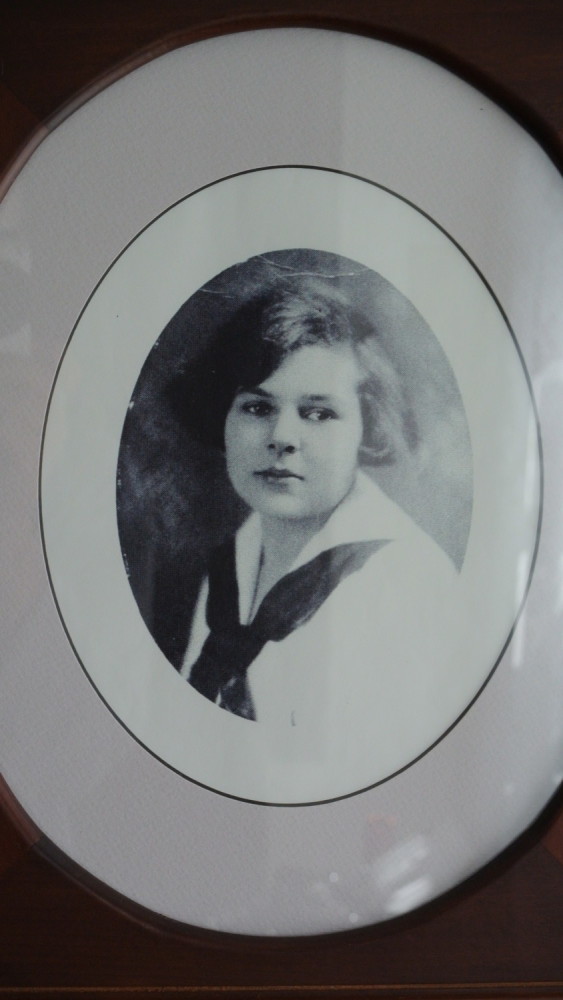
Elizabeth Bishop in her teens
Elizabeth all her life retained connections with her mother’s family and the landscape and seascape of Nova Scotia. Her poems and prose pieces show an affinity for the sea along a line of longitude from Nova Scotia to Brazil. She lived on and off for ten years in Key West, Florida and for fifteen years in Brazil. She returned to Boston in the 1970s.
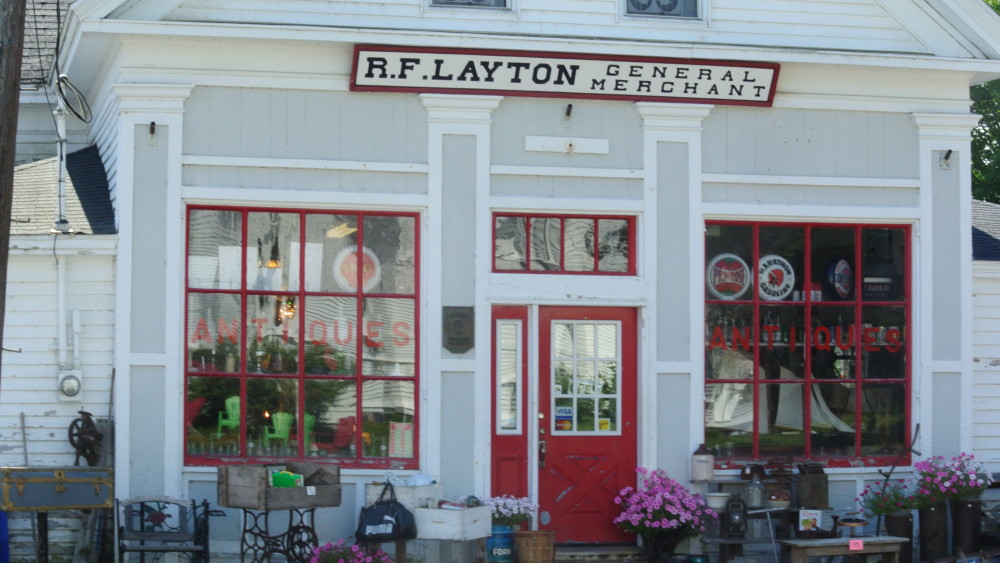
Great Village is just inland from the north shore of Minas Basin on the Bay of Fundy. The indigenous Mi’kmaq First Nation people were supplanted by the Acadians – French settlers – in the seventeenth century. Scots Ulster people in turn settled there, as is testified by the names – Londonderry, McCallum Settlement, Wilson’s Garage, Mahon Cemetery. The Great Village River runs to red-marl and silt, wharfs where a thriving shipbuilding industry kept the local economy afloat in the nineteenth century. In Bishop’s day and in ours, the village is a shadow of its former self: houses thinned out, stores become antique shops, church and coffee shop conjoined.
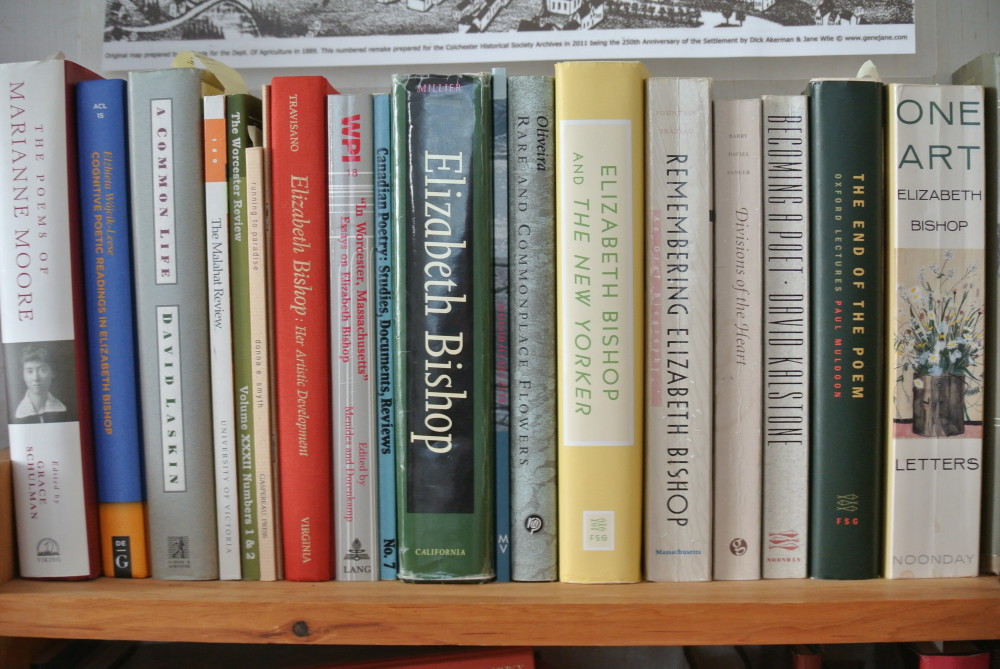
A shelfie in the Elizabeth Bishop House, Great Village, Nova Scotia
Colm Tóibín describes the landscape well in his little book On Elizabeth Bishop (Princeton University Press, 2015):
…a strange coastal flatness, with deep inlets all around. It is as though the whole place could be inundated by tides at any time. If the village is built on dry land, there is a suggestion that it was not always dry, or its dryness comes as a sort of accident, a quirk of nature. The place is filled with watery northern light…
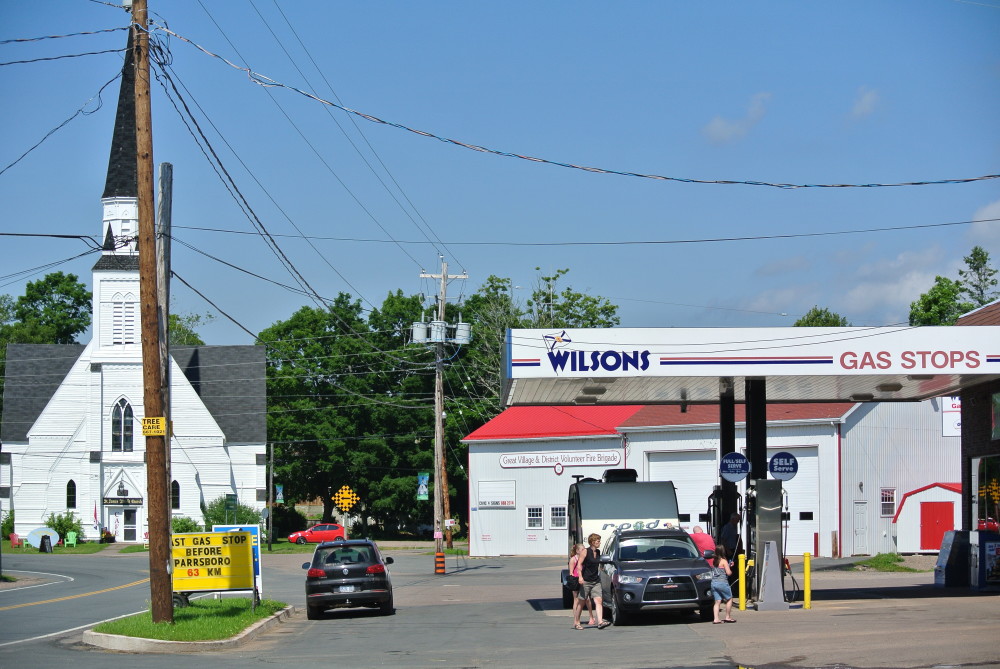
Former Esso Station on the right, St. James Presbyterian Church left
The Bulmers on her mother’s side were fairly well-to-do country people. Her grandfather was a tanner. His house, where Elizabeth Bishop spent the years 1914-1916 and summer holidays thereafter, is still standing at the junction of three roads, opposite Wilson’s Garage which was formerly an Esso Station, brought to vivid life in the poem “Filling Station”.
Somebody embroidered the doily.
Somebody waters the plant,
or oils it, maybe. Somebody
arranges the rows of cans
so that they softly say:
ESSO – SO – SO – SO
to high-strung automobiles.
Somebody loves us all.
The house is now known as Elizabeth Bishop’s House and operates as a writers’ retreat and a venue for commemorative events. Its status is precarious, though, and as I write it is up for sale to someone who will preserve its unique literary heritage.
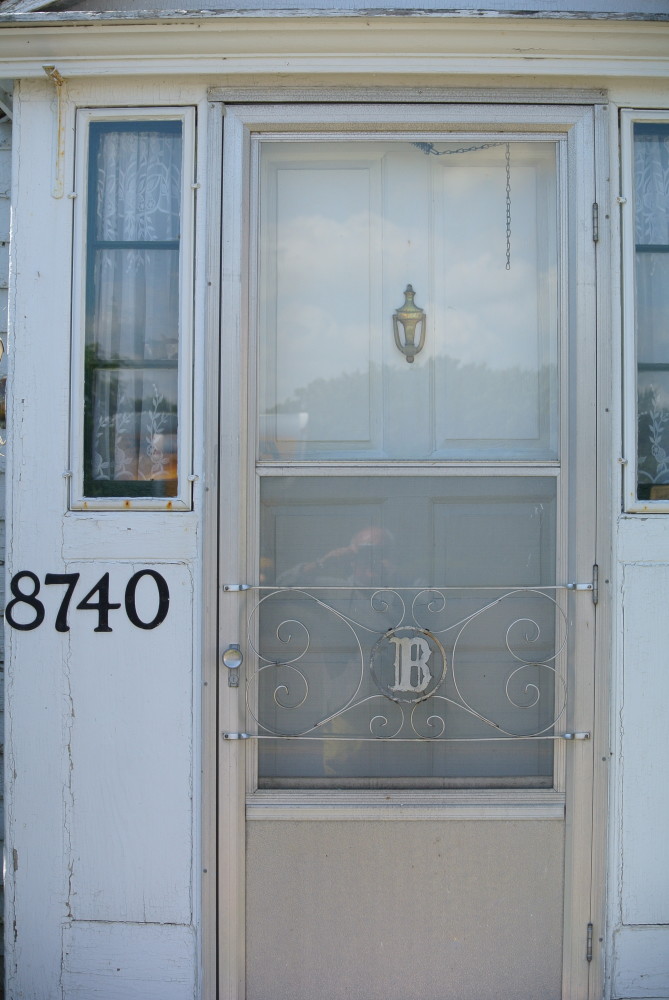
Front door of the Elizabeth Bishop House in Great Village, Nova Scotia
We were fortunate to meet photographer Laurie Gunn, who showed us around. She was busy preparing for the one-day Elizabeth Bishop Festival on the following Saturday. Laurie is President of the Elizabeth Bishop Society of Nova Scotia and explained the dilemma regarding the house and the difficulty of keeping heritage alive in such an out of the way place as Great Village, with only a summer season for visitors.

Some of the fittings and decorative objects in the house date from the beginning of the last century. Elizabeth’s tiny bedroom looks out on the road and the gas station. The kitchen and pantry used to face a blacksmith’s on one side and still face the Presbyterian church on the other. Bishop’s poems are full of objects which become talismans, signifying time and event. In “Sestina” she recalls her grandmother in the kitchen “beside the Little Marvel Stove, / reading the jokes from the almanac,”. The child watches the “teakettle’s small hard tears / dance like mad on the hot black stove.”

The Little Marvel Stove in the kitchen of Elizabeth Bishop House
A steep narrow staircase leads to the bedrooms under the eaves, with their patchwork quilts and heirloom furniture. Nova Scotia seems to have an antique shop in every village, filled with household bric à brac from farms and homesteads that have moved up in the world, or moved on to the next one. From the back windows of the Elizabeth Bishop House there is a view of the tidal basin, the land flat, the silt red, the tide out: “rich mud / in burning rivulets; / on red, gravelly roads, / down rows of sugar maples, / past clapboard farmhouses / and neat, clapboard churches, / bleached, ridged as clamshells,”.
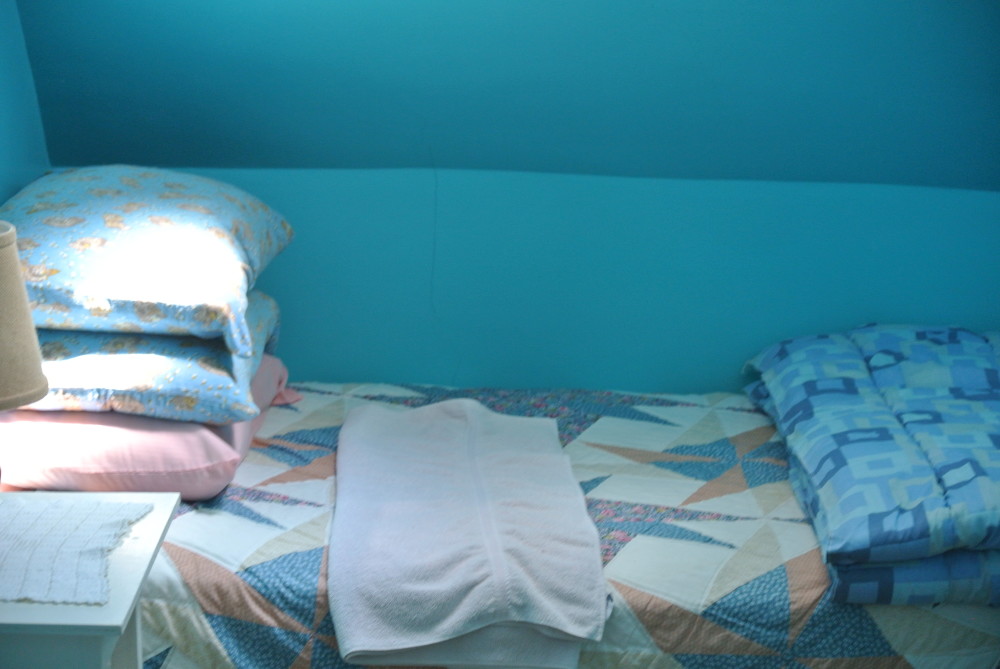
Elizabeth Bishop’s bedroom, Great Village, Nova Scotia
These rooms and views, the detail of a homeplace, as it might be termed in Ulster, were to enter her poems and prose. (My spellcheck doesn’t like the word ‘homeplace’ and keeps changing it to ‘someplace’.) In an unpublished poem called “A Short, Slow Life”, Elizabeth describes an almost crofter-like existence:
It was close, it was warm.
Along the dark seam of the river
the houses, the barns, the two churches,
hid like white crumbs
in a fluff of gray willows and elms,

Bishop’s prose memoir “In the Village” recalls her childhood, leading a cow to pasture, all the details of parish pump and local characters. In the poems it is the sea that steps forward, proffering “wave after wave”. “The Moose” describes the Nova Scotia maritime landscape perfectly, its long dull distances determined by the inroads of the sea, its map dotted with “Wilderness Areas”, a cartographer’s nod to how recently this part of the world has been settled by Europeans:
From narrow provinces
of fish and bread and tea,
home of the long tides
where the bay leaves the sea
twice a day and takes
the herrings long rides,
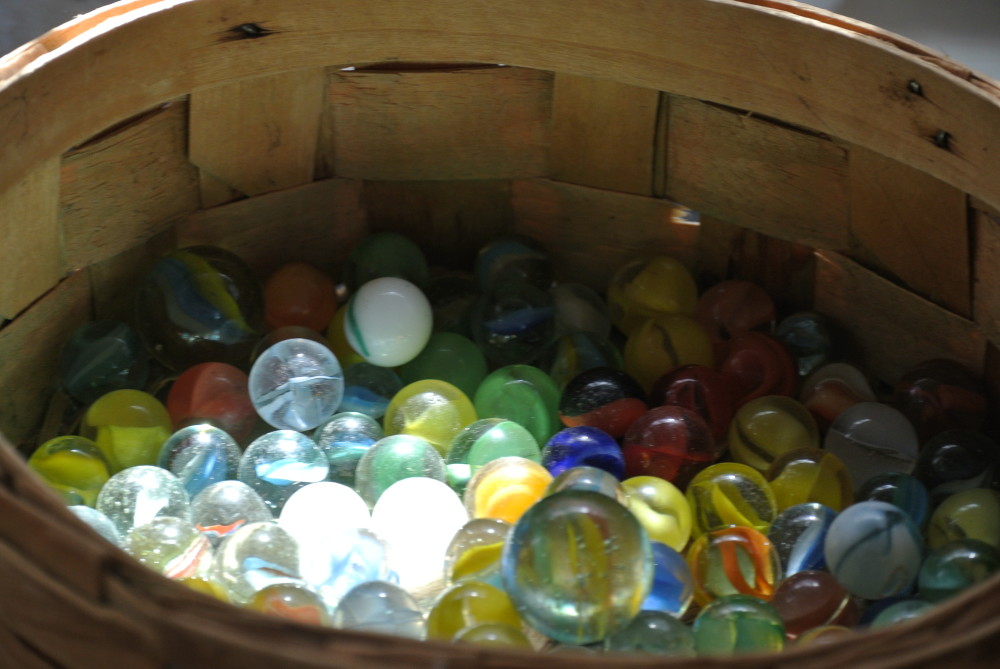
One of her great uncles was a painter of local renown (“Your Uncle George … You know, he was quite famous, an R. A….) and in “Poem” she considers the virtues of ordinariness as a wellspring of art:
Useless and free, it has spent seventy years
as a minor family relic
handed along collaterally to owners
who looked at it sometimes, or didn’t bother to.
One of Uncle George’s paintings, a self-portrait, still hangs in the parlour. Bishop’s “Poem” memorialises “this literal small backwater” and how insignificant the homeplace can be, viewed from a distance, and yet suffused with personal significance, the progenitor of art. She understood the delicate balance in poetry between being true to life and the hallucinatory, the vision, a balance Colm Tóibín compares to Vermeer or to the Danish painter Vilhelm Hammershøi.
… how touching in detail
– the little that we get for free,
the little of our earthly trust. Not much.
About the size of our abidance
along with theirs: the munching cows,
the iris, crisp and shivering, the water
still standing from spring freshets,
the yet-to-be dismantled elms, the geese.
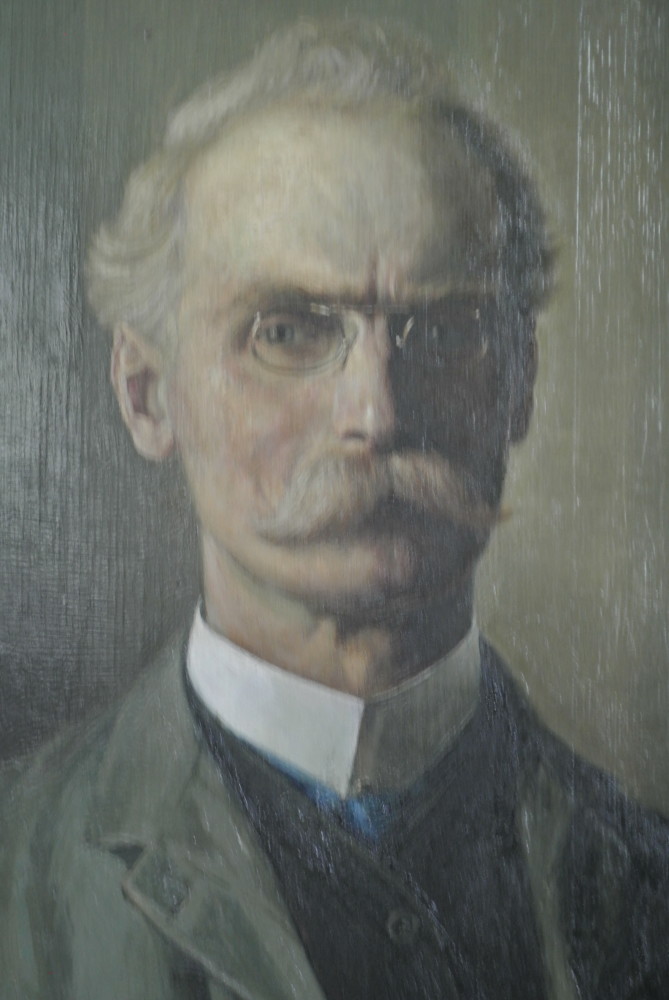
Great Uncle George’s (R. A.) self-portrait


